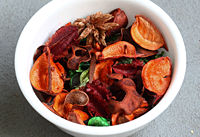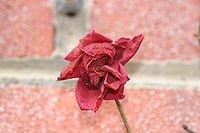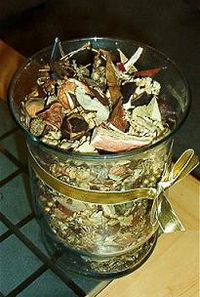
Potpourri
Encyclopedia

Plant
Plants are living organisms belonging to the kingdom Plantae. Precise definitions of the kingdom vary, but as the term is used here, plants include familiar organisms such as trees, flowers, herbs, bushes, grasses, vines, ferns, mosses, and green algae. The group is also called green plants or...
material, used to provide a gentle natural scent in houses. It is usually placed in a decorative wood
Wood
Wood is a hard, fibrous tissue found in many trees. It has been used for hundreds of thousands of years for both fuel and as a construction material. It is an organic material, a natural composite of cellulose fibers embedded in a matrix of lignin which resists compression...
en bowl, or tied in small sachet
Sachet (scented bag)
A sachet is a small cloth scented bag filled with herbs, potpourri, or aromatic ingredients.It is also defined as a small soft bag containing perfumed or sweet-smelling items also referred to as an ascent bag, scent bag, sweet bag, sachet bag, sachet de senteurs, spiced sachet, potpourri sachet,...
made from sheer fabric.
Potpourri is used inside the home to give the air a pleasant smell. The word "potpourri" comes into English from the French
French language
French is a Romance language spoken as a first language in France, the Romandy region in Switzerland, Wallonia and Brussels in Belgium, Monaco, the regions of Quebec and Acadia in Canada, and by various communities elsewhere. Second-language speakers of French are distributed throughout many parts...
word "pot-pourri." The French term has two connotations. It is the French name for a Spanish
Spain
Spain , officially the Kingdom of Spain languages]] under the European Charter for Regional or Minority Languages. In each of these, Spain's official name is as follows:;;;;;;), is a country and member state of the European Union located in southwestern Europe on the Iberian Peninsula...
stew with a wide variety of ingredients called "olla podrida
Olla podrida
Olla podrida is a Spanish stew made from pork and beans and an inconsistent, wide variety of other meats and vegetables, often including chickpeas, depending on the recipe used. The meal is traditionally prepared in a clay pot over several hours...
," specialty of the town of Burgos
Burgos
Burgos is a city of northern Spain, historic capital of Castile. It is situated at the edge of the central plateau, with about 178,966 inhabitants in the city proper and another 20,000 in its suburbs. It is the capital of the province of Burgos, in the autonomous community of Castile and León...
. The word was taken and copied by the French military during the Napoleonic occupation of Burgos (1808-1813)." Literally, however, the word "pot" in French has the same meaning as it does in Spanish and English, while the word "pourri" means rotten. In English, "potpourri" is often used to refer to any collection of miscellaneous or diverse items.
In early 17th Century France
France
The French Republic , The French Republic , The French Republic , (commonly known as France , is a unitary semi-presidential republic in Western Europe with several overseas territories and islands located on other continents and in the Indian, Pacific, and Atlantic oceans. Metropolitan France...
fresh herbs and flowers were gathered—starting in spring and continuing throughout the summer. The herbs were left for a day or two to become limp, then layered with coarse sea salt
Sea salt
Sea salt, salt obtained by the evaporation of seawater, is used in cooking and cosmetics. It is historically called bay salt or solar salt...
. The aging mixture was stirred occasionally as layers were added to it. Often the mixture would ferment
Fermentation (biochemistry)
Fermentation is the process of extracting energy from the oxidation of organic compounds, such as carbohydrates, using an endogenous electron acceptor, which is usually an organic compound. In contrast, respiration is where electrons are donated to an exogenous electron acceptor, such as oxygen,...
or even mold as the summer went by. In fall, spices would be added to the unsightly grey mix until a pleasant fragrance was achieved, then scent preserving fixatives (see below) were added. The finished potpourri was set out in special pots with perforated lids to perfume rooms. Modern homes avoid having pots of moldly substances laying about, and potpourri is usually purchased in stores.

- allspiceAllspiceAllspice, also called Jamaica pepper, pepper, myrtle pepper, pimenta, or newspice, is a spice that is the dried unripe fruit of Pimenta dioica , a mid-canopy tree native to the Greater Antilles, southern Mexico, and Central America, now cultivated in many warm parts of the world...
, - cedar wood shavings (toxic, a moth repellent),
- cinnamonCinnamonCinnamon is a spice obtained from the inner bark of several trees from the genus Cinnamomum that is used in both sweet and savoury foods...
bark and cassia bark (smells like cinnamon only less potent) - cloves,
- cypressCupressaceaeThe Cupressaceae or cypress family is a conifer family with worldwide distribution. The family includes 27 to 30 genera , which include the junipers and redwoods, with about 130-140 species in total. They are monoecious, subdioecious or dioecious trees and shrubs from 1-116 m tall...
wood shavings (toxic, a moth repellent), - fennelFennelFennel is a plant species in the genus Foeniculum . It is a member of the family Apiaceae . It is a hardy, perennial, umbelliferous herb, with yellow flowers and feathery leaves...
seed, - incense-cedar wood shavings
- jasmineJasmineJasminum , commonly known as jasmines, is a genus of shrubs and vines in the olive family . It contains around 200 species native to tropical and warm temperate regions of the Old World...
flowers and oil, - jujubeJujubeZiziphus zizyphus , commonly called jujube , red date, Chinese date, Korean date, or Indian date is a species of Ziziphus in the buckthorn family Rhamnaceae, used primarily as a fruiting shade tree.-Distribution:Its precise natural distribution is uncertain due to extensive cultivation,...
flowers and blooms, - juniperJuniperJunipers are coniferous plants in the genus Juniperus of the cypress family Cupressaceae. Depending on taxonomic viewpoint, there are between 50-67 species of juniper, widely distributed throughout the northern hemisphere, from the Arctic, south to tropical Africa in the Old World, and to the...
wood shavings (toxic, a moth repellent), - lavenderLavenderThe lavenders are a genus of 39 species of flowering plants in the mint family, Lamiaceae. An Old World genus, distributed from Macaronesia across Africa, the Mediterranean, South-West Asia, Arabia, Western Iran and South-East India...
leaves and flowers, - lemon balmLemon balmLemon balm , not to be confused with bee balm, Monarda species, is a perennial herb in the mint family Lamiaceae, native to southern Europe and the Mediterranean region....
leaves and flowers, - lemonLemonThe lemon is both a small evergreen tree native to Asia, and the tree's ellipsoidal yellow fruit. The fruit is used for culinary and non-culinary purposes throughout the world – primarily for its juice, though the pulp and rind are also used, mainly in cooking and baking...
peel, - marjoramMarjoramMarjoram is a somewhat cold-sensitive perennial herb or undershrub with sweet pine and citrus flavours...
leaves and flowers, - Mignonette leaves and flowers,
- mintMenthaMentha is a genus of flowering plants in the family Lamiaceae . The species are not clearly distinct and estimates of the number of species varies from 13 to 18. Hybridization between some of the species occurs naturally...
leaves and flowers, - mugwort (toxic, adds a musky note, a moth repellent)
- orangeOrange (fruit)An orange—specifically, the sweet orange—is the citrus Citrus × sinensis and its fruit. It is the most commonly grown tree fruit in the world....
peel, - pinyon pinePinyon pineThe pinyon pine group grows in the southwestern United States and in Mexico. The trees yield edible pinyon nuts, which were a staple of the Native Americans, and are still widely eaten...
shavings and cones (seeds edible, bark toxic), - roseRoseA rose is a woody perennial of the genus Rosa, within the family Rosaceae. There are over 100 species. They form a group of erect shrubs, and climbing or trailing plants, with stems that are often armed with sharp prickles. Flowers are large and showy, in colours ranging from white through yellows...
flowers, hips, or oil, - rosemaryRosemaryRosemary, , is a woody, perennial herb with fragrant, evergreen, needle-like leaves and white, pink, purple or blue flowers, native to the Mediterranean region. It is a member of the mint family Lamiaceae, which includes many other herbs, and is one of two species in the genus Rosmarinus...
leaves and flowers,
Much modern potpourri consists of any decoratively shaped dried plant material (not necessarily from scented plants) with strong synthetic perfume
Perfume
Perfume is a mixture of fragrant essential oils and/or aroma compounds, fixatives, and solvents used to give the human body, animals, objects, and living spaces "a pleasant scent"...
s (and also often strongly colored dye
Dye
A dye is a colored substance that has an affinity to the substrate to which it is being applied. The dye is generally applied in an aqueous solution, and requires a mordant to improve the fastness of the dye on the fiber....
s) added, with the scent often bearing no relation to the plant material used. Sometimes, items which do not originate from plants are mixed in with the potpourri, to give it bulk and to make it more aesthetically pleasing. It is possible to spray scents onto potpourri, however a fixative is needed so that the scent is absorbed for slow release. Generally, orris root
Orris root
Orris root is a term used for the roots Iris germanica, Iris florentina, and Iris pallida. Once important in western herbal medicine, it is now used mainly as a fixative and base note in perfumery, as well as an ingredient in many brands of gin....
is used for this purpose.
The number of plant species used in potpourri is large. Researchers have identified 300 species from 95 families, including fungi and lichen
Lichen
Lichens are composite organisms consisting of a symbiotic organism composed of a fungus with a photosynthetic partner , usually either a green alga or cyanobacterium...
s. A few toxic ingredients have been found, such as fruits from Strychnos nux-vomica, the strychnine tree.


